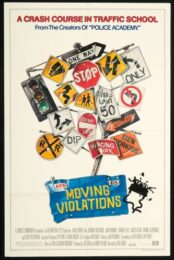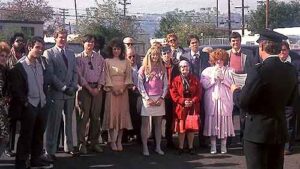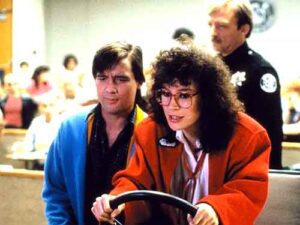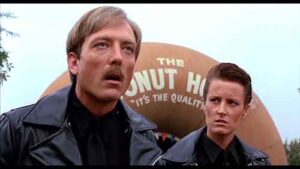The “institutional comedy” model, established in 1984 by POLICE ACADEMY, was given a fair-to-middling workout in this film, released almost exactly a year later. That’s a mighty fast turnaround, and the rapidity with which MOVING VIOLATIONS was made (a reported six months passed between the writing of the script and the April 1985 theatrical release) is all too evident in the finished product.
There is, however, an interesting angle that few people have picked up on: the film is science fiction themed (having been filmed in 1984, the genre’s most iconic year) and can be viewed as a sequel of sorts to Neal Israel’s futuristic comedy AMERICATHON (1979). MOVING VIOLATIONS holds up much better, in any event, than POLICE ACADEMY, its sequels or its institutional comedy wannabes (BAD MEDICINE, COMBAT HIGH, RECRUITS, FEDS, etc.).
In the dystopian Birch County, whose motto is “The Future is Now,” cops drive Trans Ams and government-run schools are mandated for anyone with a traffic citation. When Dana Cannon (John Murray), a smart-assed florist, gets a ticket from the sadistic Deputy Halik (James Keach), he sees just what this traffic school entails: nighttime classes run by Halik, who impounds his students’ cars and oversees automated driving courses.
Others stuck in this traffic school from hell include the attractive Amy (Jennifer Tilly), about whom Dana claims “she’s no rocket scientist,” when in fact that’s exactly what she is; the sickly Joan (Wendie Jo Sperber), who mistakes talk about her car’s rear end from fellow student Doc Williams (Fred Willard), a mechanic, for medical advice; rebellious teen Stephanie (Nadine Van der Velde), who loves stealing cars but masquerades as a daddy’s girl, and the nerdy Scott (Brian Backer), who develops a crush on Stephanie and becomes an accomplice to her troublemaking; and Wink (Ned Eisenberg), a seriously obnoxious horror movie enthusiast.
Then it’s discovered that Halik and his paramour, the corrupt Judge Henderson (Sally Kellerman), are looking to defraud taxpayers. It’s up to Dana and his cohorts to find evidence and, in a very BLUES BROTHERS-like climax, outrun a fleet of hostile cops and present that evidence to the police chief (an uncredited Robert Conrad).
It’s too bad about the hasty production, because there was real talent in front of and behind the camera. Cinematographer Robert Elswit provides strong and even-toned lighting that offers an effective preview of his work on the films of Paul Thomas Anderson, and the veteran stunt coordinator Glenn R. Wilder (1933-2017) pulls off some impressive action sequences, performed by many of Hollywood’s top stunt performers. James Keach (known at the time for being, like his co-stars John Murray and Jennifer Tilly, a sibling of a more famous performer, in this case Stacey Keach) brings real intensity to the role of Deputy Halik, while skilled comedy thespians like Sally Kellerman (1937-2022), Fred Willard (1933-2020) and Wendie Jo Sperber (1958-2005) all do what they can with underwritten roles.
The film’s issues extend to the clumsy tonal changes, wardrobes that have a tendency to change between close-ups and wide shots, background extras who look directly into the camera and comedic set-pieces that are, to say the least, ill-thought out (why does Doc Williams advise Joan to bring her car to him when he knows the car has been impounded?). There are some funny bits, most of which involve the 76-year-old Nedra Volz (1908-2003) as a dotty old lady who among other things mouths the word (the “F dash-dash-dash word”) that got the film its PG-13 rating (eighties nostalgists will also get a kick out of a cameo by Clara Peller, of “Where’s the beef?” fame, who does a soundalike reprise).
Most affected by the haste-makes-waste aesthetic is John Murray in his first and only lead role. Murray’s performance has been criticized for being imitative of the mannerisms displayed by his brother Bill, but John’s look and reactions are unique enough to make one lament that his character is so underwritten. The film’s failure appears to have permanently derailed his acting career, but had things gone differently (i.e. if he were given a proper script to work with) John Murray might well have gone the distance.
Vital Statistics
MOVING VIOLATIONS
Twentieth Century Fox
Director: Neal Israel
Producers: Joe Roth, Harry Ufland
Screenplay: Neal Israel, Pat Proft
Cinematography: Robert Elswit
Editing: Tom Walls
Cast: John Murray, Jennifer Tilly, James Keach, Brian Backer, Ned Eisenberg, Clara Peller, Wendie Jo Sperber, Nedra Volz, Fred Willard, Lisa Hart Carroll, Nadine Van der Velde, Ben Mittleman, Victor Campos, Willard E. Pugh, Sally Kellerman, Robert Conrad, Joe Alfasa, Elizabeth Arlen




